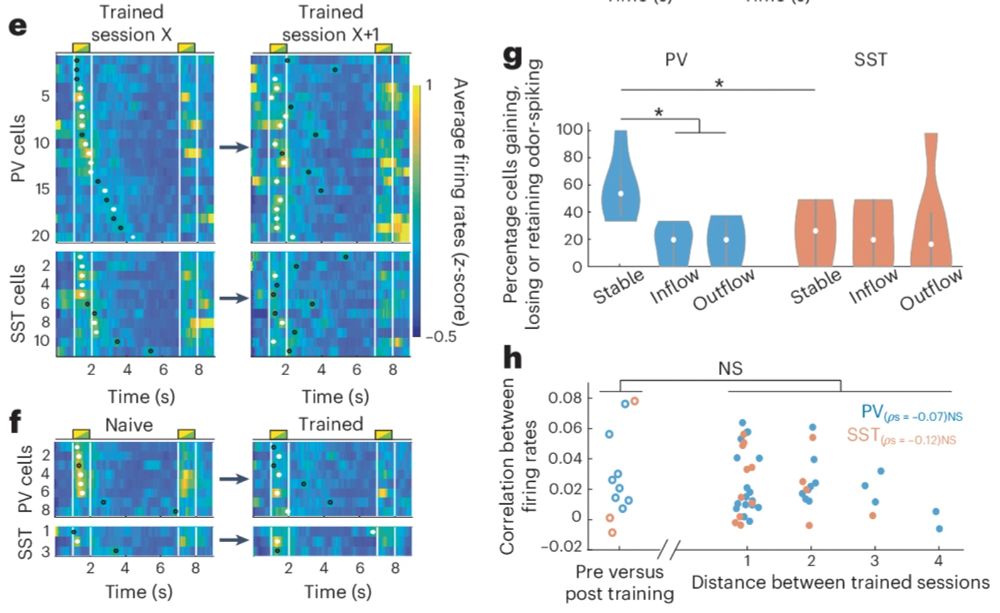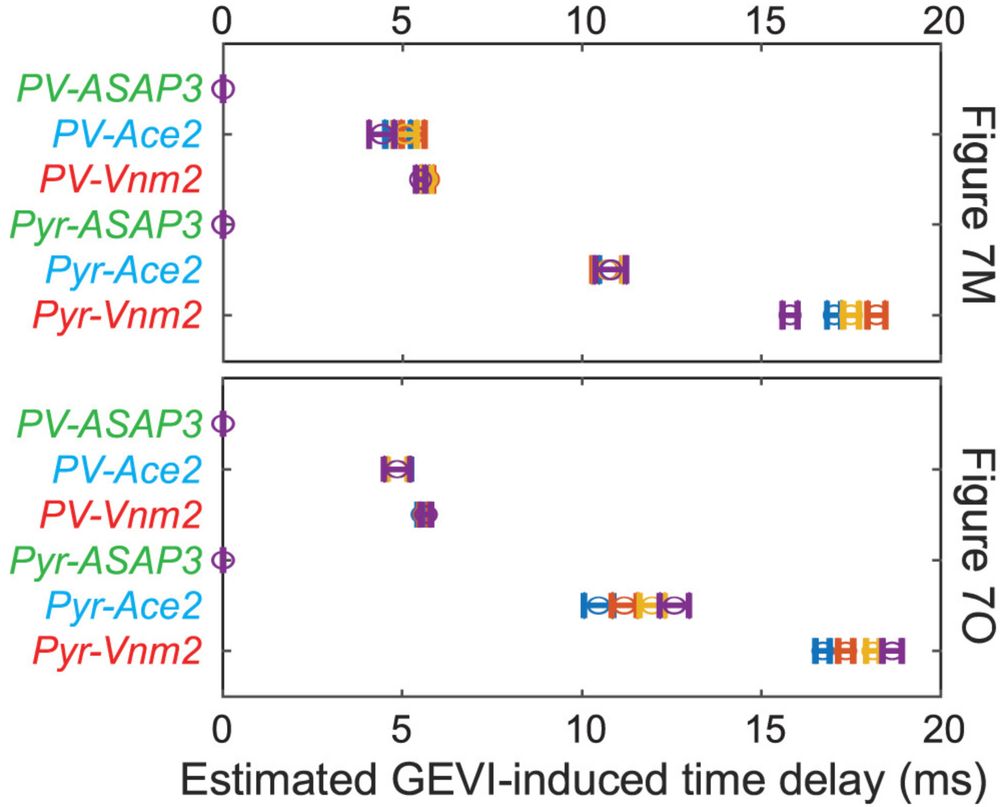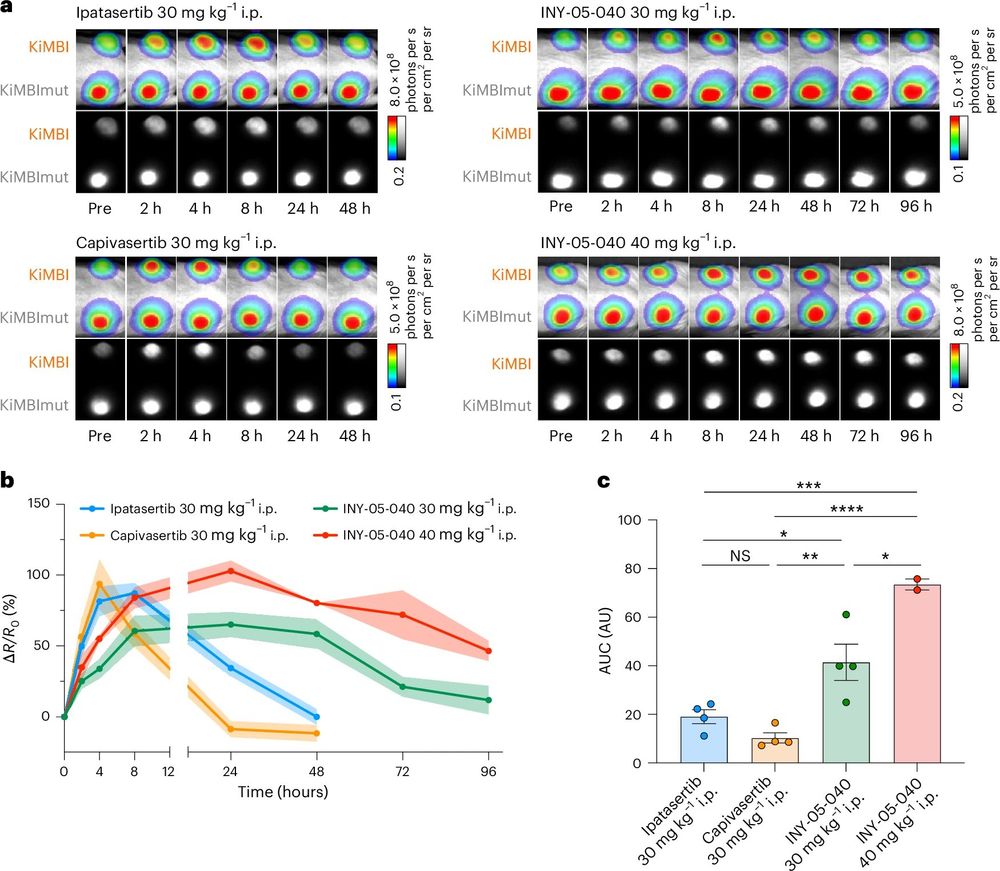Michael Lin, MD PhD
@michaelzlin.bsky.social
Harvard → UCLA → HMS → UCSD → Associate Prof. of Neurobiology & Bioengineering at Stanford → Molecules, medicines, & SARSCoV2. Bad manners blocked.
My daughter made a series of Halloween cats using air clay. Can you recognize them all?



October 21, 2025 at 7:12 PM
My daughter made a series of Halloween cats using air clay. Can you recognize them all?
Had the pleasure of visiting Prague as part of an advisory commission for the Czech Academy of Sciences Institute of Biotechnology. Got to check out exciting science and the impressive ultra-high resolution MS machine.
Great to see people working hard to expand knowledge, with public support too!
Great to see people working hard to expand knowledge, with public support too!



September 30, 2025 at 2:32 PM
Had the pleasure of visiting Prague as part of an advisory commission for the Czech Academy of Sciences Institute of Biotechnology. Got to check out exciting science and the impressive ultra-high resolution MS machine.
Great to see people working hard to expand knowledge, with public support too!
Great to see people working hard to expand knowledge, with public support too!
First clouds over Stanford since spring

September 11, 2025 at 1:30 AM
First clouds over Stanford since spring
Interestingly they could use ASAP3 to record spiking responses of the same neurons over days, before and after training, allowing them to show that about half of the PV interneurons that respond to odor one day remain responsive the next day. Pyramidals learn more stably, SST interneurons worse.

July 24, 2025 at 10:33 PM
Interestingly they could use ASAP3 to record spiking responses of the same neurons over days, before and after training, allowing them to show that about half of the PV interneurons that respond to odor one day remain responsive the next day. Pyramidals learn more stably, SST interneurons worse.
GCaMP3 failed to find statistically different responses in the neuropathic pain state. It's not clear why, but it could be that calcium primarily picks up large spike bursts, as we showed in the original ASAP4 study, while hypersensitivity may result in a higher frequency of smaller bursts.

July 17, 2025 at 10:08 PM
GCaMP3 failed to find statistically different responses in the neuropathic pain state. It's not clear why, but it could be that calcium primarily picks up large spike bursts, as we showed in the original ASAP4 study, while hypersensitivity may result in a higher frequency of smaller bursts.
Here, ASAP4e reported firing in the dorsal root ganglia (cell bodies of touch-sensing neurons) upon light touch and pressure stimuli. ASAP43 also reported larger responses after neuropathic pain is induced immunologically (complete Freund's adjuvant) or neurologically (sciatic nerve constriction).

July 17, 2025 at 9:58 PM
Here, ASAP4e reported firing in the dorsal root ganglia (cell bodies of touch-sensing neurons) upon light touch and pressure stimuli. ASAP43 also reported larger responses after neuropathic pain is induced immunologically (complete Freund's adjuvant) or neurologically (sciatic nerve constriction).
ASAP3 ("PV-INs" and green in other plots) also picks up 30-70Hz gamma waves in the cortex upon visual stimulation, whereas an opsin-based indicator (red) did not, apparently due to slower responses.
It's also nice to see our mRuby2 and CyOFP being useful in the brain as non-toxic orange-red FPs.
It's also nice to see our mRuby2 and CyOFP being useful in the brain as non-toxic orange-red FPs.


July 17, 2025 at 8:01 PM
ASAP3 ("PV-INs" and green in other plots) also picks up 30-70Hz gamma waves in the cortex upon visual stimulation, whereas an opsin-based indicator (red) did not, apparently due to slower responses.
It's also nice to see our mRuby2 and CyOFP being useful in the brain as non-toxic orange-red FPs.
It's also nice to see our mRuby2 and CyOFP being useful in the brain as non-toxic orange-red FPs.
Theta waves arise during exploration and entrain the spiking of pyramidal neurons to facilitate the emergence of place-specific encoding in the hippocampus. ASAP3 mesoscale imaging in the hippocampus finds that theta waves propagate in 1 direction in excitatory neurons, but 2 in inhibitory neurons.

July 17, 2025 at 7:48 PM
Theta waves arise during exploration and entrain the spiking of pyramidal neurons to facilitate the emergence of place-specific encoding in the hippocampus. ASAP3 mesoscale imaging in the hippocampus finds that theta waves propagate in 1 direction in excitatory neurons, but 2 in inhibitory neurons.
If you're interested in optical reporting of neuronal activity, and can get to Venice, there are a couple of spots left at the Neuroscience School of Advanced Studies in Neurophotonics, 5/31 to 6/7.
www.neurosas.org/advanced-cou...
www.neurosas.org/advanced-cou...

May 9, 2025 at 2:55 PM
If you're interested in optical reporting of neuronal activity, and can get to Venice, there are a couple of spots left at the Neuroscience School of Advanced Studies in Neurophotonics, 5/31 to 6/7.
www.neurosas.org/advanced-cou...
www.neurosas.org/advanced-cou...
A NYT story this week reveals, unsurprisingly, that Miller is also making personal decisions on cancelling funding to specific universities. "A few powerful aides in the West Wing, including Mr. Miller, have separately moved to stymie funding for major institutions."
www.nytimes.com/2025/04/14/u...
www.nytimes.com/2025/04/14/u...

April 15, 2025 at 7:35 PM
A NYT story this week reveals, unsurprisingly, that Miller is also making personal decisions on cancelling funding to specific universities. "A few powerful aides in the West Wing, including Mr. Miller, have separately moved to stymie funding for major institutions."
www.nytimes.com/2025/04/14/u...
www.nytimes.com/2025/04/14/u...
The 3 MIDAS steps yielded >20x improved responses to 100 μM ACh, enabling detection of ACh in mice with more than a 170-fold increase in bioluminescence.
This indicator, acetylcholine neurotransmitter bioluminescent indicator (NeuBI) is the largest fold-response indicator we have engineered so far.
This indicator, acetylcholine neurotransmitter bioluminescent indicator (NeuBI) is the largest fold-response indicator we have engineered so far.

April 4, 2025 at 5:52 PM
The 3 MIDAS steps yielded >20x improved responses to 100 μM ACh, enabling detection of ACh in mice with more than a 170-fold increase in bioluminescence.
This indicator, acetylcholine neurotransmitter bioluminescent indicator (NeuBI) is the largest fold-response indicator we have engineered so far.
This indicator, acetylcholine neurotransmitter bioluminescent indicator (NeuBI) is the largest fold-response indicator we have engineered so far.
The mutation of 1 site to all 20 AAs is already impossible by random mutagenesis (mutation rates high enough to achieve the 3nt changes in a codon to get all 20 AAs will kill the gene through mutations elsewhere)... but MIDAS can do even more: It can mutate 2 sites to all 400 possible combinations.

April 4, 2025 at 5:46 PM
The mutation of 1 site to all 20 AAs is already impossible by random mutagenesis (mutation rates high enough to achieve the 3nt changes in a codon to get all 20 AAs will kill the gene through mutations elsewhere)... but MIDAS can do even more: It can mutate 2 sites to all 400 possible combinations.
We used MIDAS over 3 rounds to optimize a new bioluminescent acetylcholine (ACh) sensor, screening lengths of interdomain linkers to improve responses and sites near the ACh pocket to improve binding. Here are the results of screening all 20 amino acids at 16 sites.

April 4, 2025 at 5:41 PM
We used MIDAS over 3 rounds to optimize a new bioluminescent acetylcholine (ACh) sensor, screening lengths of interdomain linkers to improve responses and sites near the ACh pocket to improve binding. Here are the results of screening all 20 amino acids at 16 sites.
All you need are short primers encoding each mutation you want. The two PCR rounds assemble mutant and constant gene portions. Then you just add a little bit of reaction into your lipofection mix. Very easy when using 96- or 384-well PCR blocks. Works as well as plasmid transfection!

April 4, 2025 at 5:37 PM
All you need are short primers encoding each mutation you want. The two PCR rounds assemble mutant and constant gene portions. Then you just add a little bit of reaction into your lipofection mix. Very easy when using 96- or 384-well PCR blocks. Works as well as plasmid transfection!
To accomplish this, we developed microbial-independent deep assembly and screening (which hmm spells MIDAS!).
MIDAS is super-simple: Make complete mammalian genes by two rounds of PCR, then transfect the PCR products into mammalian cells in microwells. The next day, perform high-quality analysis.
MIDAS is super-simple: Make complete mammalian genes by two rounds of PCR, then transfect the PCR products into mammalian cells in microwells. The next day, perform high-quality analysis.

April 4, 2025 at 5:29 PM
To accomplish this, we developed microbial-independent deep assembly and screening (which hmm spells MIDAS!).
MIDAS is super-simple: Make complete mammalian genes by two rounds of PCR, then transfect the PCR products into mammalian cells in microwells. The next day, perform high-quality analysis.
MIDAS is super-simple: Make complete mammalian genes by two rounds of PCR, then transfect the PCR products into mammalian cells in microwells. The next day, perform high-quality analysis.
Helping my sister spread the word about a one-of-a-kind experiential trip to Japan with hot springs, a beer factory, and temple and home stays.
Date: 2025 October 13-27
More information at www.sunnyvalesistercity.org/programs_AEP.html
Date: 2025 October 13-27
More information at www.sunnyvalesistercity.org/programs_AEP.html


March 17, 2025 at 12:07 AM
Helping my sister spread the word about a one-of-a-kind experiential trip to Japan with hot springs, a beer factory, and temple and home stays.
Date: 2025 October 13-27
More information at www.sunnyvalesistercity.org/programs_AEP.html
Date: 2025 October 13-27
More information at www.sunnyvalesistercity.org/programs_AEP.html
Incidentally Kansas City has the only airport in the US I know that allows glass walls on the jet bridge. That's the norm in other countries but almost all fire departments in the US don't allow them.

February 28, 2025 at 12:54 AM
Incidentally Kansas City has the only airport in the US I know that allows glass walls on the jet bridge. That's the norm in other countries but almost all fire departments in the US don't allow them.
Kansas City seems to be thriving as well, with a vibrant downtown and a new airport.

February 28, 2025 at 12:54 AM
Kansas City seems to be thriving as well, with a vibrant downtown and a new airport.
A view of the institute. It's not small.

February 28, 2025 at 12:49 AM
A view of the institute. It's not small.
NIH memo issued yesterday restarts award issuance, confirms they should have restarted after the 1/31 court ruling
popular.info/p/breaking-n...
popular.info/p/breaking-n...

February 13, 2025 at 11:22 PM
NIH memo issued yesterday restarts award issuance, confirms they should have restarted after the 1/31 court ruling
popular.info/p/breaking-n...
popular.info/p/breaking-n...
Interestingly, even non-covalent inhibitors of Akt showed PD extending many hours beyond PK. Naively you might think PD would be contained within PK, but that may not be the case if a drug has some protein-degrading activity or inactivation of a protein inhibits its own production.

February 13, 2025 at 9:37 PM
Interestingly, even non-covalent inhibitors of Akt showed PD extending many hours beyond PK. Naively you might think PD would be contained within PK, but that may not be the case if a drug has some protein-degrading activity or inactivation of a protein inhibits its own production.
Finally using Akt KiMBI we find unexpectedly long PD effects of the PROTAC Akt degrader synthesized by collaborator Nathanael Gray's lab. In fact, one injection of the degrader, INY-05-040, activated Akt KiMBI (i.e. inhibited Akt) with a half-life of almost 96 hours (4 days)!

February 13, 2025 at 9:37 PM
Finally using Akt KiMBI we find unexpectedly long PD effects of the PROTAC Akt degrader synthesized by collaborator Nathanael Gray's lab. In fact, one injection of the degrader, INY-05-040, activated Akt KiMBI (i.e. inhibited Akt) with a half-life of almost 96 hours (4 days)!
The efficiency and speed of Akt KiMBI imaging allowed us to test brain activity of Akt inhibitors that we custom synthesized at only the initial 25mg scale. We found a new inhibitor with brain activity, ML-B01.

February 13, 2025 at 9:37 PM
The efficiency and speed of Akt KiMBI imaging allowed us to test brain activity of Akt inhibitors that we custom synthesized at only the initial 25mg scale. We found a new inhibitor with brain activity, ML-B01.
We also visualized capivasertib activity in the brain using the BBB-permeant cephalofurimazine (also identified earlier in collaboration with Promega).
Note we find raw grayscale images easier to understand, as in fluorescence, but add pseudocolor overlays as customary in mouse imaging.
Note we find raw grayscale images easier to understand, as in fluorescence, but add pseudocolor overlays as customary in mouse imaging.

February 13, 2025 at 9:37 PM
We also visualized capivasertib activity in the brain using the BBB-permeant cephalofurimazine (also identified earlier in collaboration with Promega).
Note we find raw grayscale images easier to understand, as in fluorescence, but add pseudocolor overlays as customary in mouse imaging.
Note we find raw grayscale images easier to understand, as in fluorescence, but add pseudocolor overlays as customary in mouse imaging.


